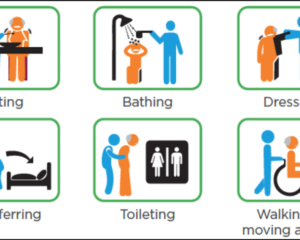Occupational Therapy for Activities of Daily Living (Adl)

Occupational therapy is an essential part of a rehabilitation program, as it allows individuals to get back to a productive, independent lifestyle.
Over one-third of occupational therapists work with older adults who have been affected by illness, injury, disability or mental health condition. In fact, occupational therapists are often advocates for the elderly, working with local community groups and governments to ensure each is doing their part to allow seniors to maintain as much independence as possible.
Occupational therapy for seniors has a special focus on what the individual is still capable of doing, rather than what they cannot do, and helping them overcome their limitations or challenges.
Occupational therapists also educate family caregivers, helping them find the support and assistance they may need to continue to provide the highest quality care for their aging loved ones at home.
ADLs and Occupational Therapy for seniors:
Often by utilizing adaptive tools, occupational therapy incorporates meaningful activities to improve life skills and promote participation in everyday life.
Through education, rehabilitation techniques and exercise, occupational therapists encourage the re-learning and improvement of fine motor skills, strength and dexterity.
The occupational therapist will first evaluate and assess the condition of the individual.
The therapist will determine which types of activities can be performed without any assistance, which need some assistance, and which cannot be completed at all.
Then, they will develop a personalized plan of care based on the nature and degree of the dysfunction, as well as what special services and therapeutic interventions may be needed.
Occupational therapy is key to restoring abilities to perform basic activities of daily living (ADLs), also called self-care activities.
Being able to complete these ADLs successfully allows seniors to remain as independent as possible, hopefully getting them back to their pre-illness or pre-injury lifestyle. Some of the activities of daily living occupational therapy helps improve or restore include:
Eating and feeding oneself
Bathing and showering
Mobility – getting up and down, moving around while performing activities
Personal hygiene/grooming – brushing teeth, washing and combing hair, etc.
Toileting
More complex daily activities like cooking, writing, cleaning, etc.
Occupational therapists can also aid in creating a safe home environment for the senior to return to after a stay in a skilled nursing facility.
They will visit the home and note where modifications may be needed to make life easier, such as installing grab bars or a seat in the shower in a bathroom, as well as recommend assistive devices or home improvements that will help seniors complete tasks and live as safely as possible.
As therapy progresses, the occupational therapist will regularly re-evaluate the personalized care plan and make whatever adjustments may be needed.
They will observe which goals are being met and which are not, and change the intervention plan to adapt to the areas that need more work.
Specific fine motor skills encouraged in these activities include:
Place coins in the slit of a plastic container.
Pinch tooth picks and drop them in the holes of a spice container.
Pour small items back and forth between containers.
Paint with sponge shapes.
Push beads into play dough.
Make shapes in play dough with cookie cutters.
Use tweezers or chopsticks for picking up small objects.
Clothespin activities
Peel fruits
- Turn the key in a lock.
For more details contact
us on 📞9618906780
